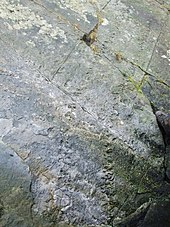Arthropleura
| Arthropleura | |
|---|---|

| |
| Fossil of A. armata at the Senckenberg Museum of Frankfurt | |

| |
| Life restoration of A. armata | |
| Scientific classification | |
| Kingdom: | Animalia |
| Phylum: | Arthropoda |
| Class: | Diplopoda |
| Order: | †Arthropleurida Waterlot, 1933 |
| Family: | †Arthropleuridae Zittel, 1885 |
| Genus: | †Arthropleura Meyer, 1854 |
| Species[1] | |
| |
| Synonyms | |
| |
Arthropleura (Greek for jointed ribs) is a genus of extinct millipede arthropods that lived in what is now northeastern North America and Scotland around 345 to 295 million years ago, from the Viséan stage of the lower Carboniferous Period to the Asselian stage of the lower Permian Period.[2] The species of the genus are the largest known land invertebrates of all time, and would have had few, if any, predators.
Description[]
Arthropleura ranged in length from only about 0.3 metres long to A. armata which was 2.5 metres long.[3] Arthropleura was able to grow larger than modern arthropods, partly because of the greater partial pressure of oxygen in Earth's atmosphere at that time and because of the lack of large terrestrial vertebrate predators.[4]
The flattened body of Arthropleura was composed of approximately 30 jointed segments, each of which was covered by two side plates and one center plate. The ratio of pairs of legs to body segments was approximately 8:6, similar to some present-day millipedes.[5]
Paleobiology[]

For a very long time,[vague] Arthropleura was believed to be an active predator and frequently portrayed as a gigantic version of the tropical centipede genus Scolopendra.[citation needed] It is now known that Arthropleura was not a predator like modern centipedes, but an herbivorous arthropod like modern millipedes. Because none of the known fossils have the mouth preserved, scientists have concluded that Arthropleura did not have strongly sclerotized and powerful mouth parts, because these would have been preserved at least in some of the fossils. Some fossils have been found with lycopod fragments and pteridophyte spores in the gut and in associated coprolites.[6]
Fossilized footprints from Arthropleura have been found in many places. These appear as long, parallel rows of small prints, which show that it moved quickly across the forest floor, swerving to avoid obstacles, such as trees and rocks. Its tracks have the ichnotaxon name Diplichnites cuithensis.[7][8] Tracks from Arthropleura up to 50 cm wide have been found at Joggins, Nova Scotia.[9]
Extinction[]
Arthropleura became extinct soon after the end of the Carboniferous period, when the moist climate began drying out, reducing the rainforests of the Carboniferous, and allowing the desertification characteristic of the Permian.[10]
See also[]
References[]
- ^ "Arthropleura". Fossilworks: Gateway to the Paleobiology Database. Retrieved 14 February 2017.
- ^ Ronald L. Martino and Stephen F. Greb (2009). "Walking Trails of the Giant Terrestrial Arthropod Arthropleura from the UpperCarboniferous of Kentucky" Archived 2019-12-23 at the Wayback Machine. Journal of Paleontology. Retrieved on 23 December 2019.
- ^ George r. Mcghee, Jr (2013-11-12). When the Invasion of Land Failed: The Legacy of the Devonian Extinctions. ISBN 9780231160575.
- ^ M. G. Lockley & Christian Meyer (2013). "The tradition of tracking dinosaurs in Europe". Dinosaur Tracks and Other Fossil Footprints of Europe. Columbia University Press. pp. 25–52. ISBN 9780231504607.
- ^ Sues, Hans-Dieter. "Largest Land-Dwelling "Bug" of All Time". National Geographic. Ford Cochran. Archived from the original on 4 March 2016. Retrieved 14 February 2017.
- ^ A. C. Scott; W. G. Chaloner & S. Paterson (1985). "Evidence of pteridophyte–arthropod interactions in the fossil record" (PDF). Proceedings of the Royal Society of Edinburgh. 86B: 133–140.
- ^ Adrian P. Hunt; Spencer G. Lucas; Allan Lerner; Joseph T. Hannibal (2004). "The giant Arthropleura trackway Diplichnites cuithensis from the Cutler Group (Upper Pennsylvanian) of New Mexico". Geological Society of America Abstracts with Programs. 36 (5): 66.
- ^ Briggs, D. E.; Plint, A. G. & Pickerill, R. K. (1984). "Arthropleura trails from the Westphalian of eastern Canada" (PDF). Palaeontology. 27 (4): 843–855. Archived from the original (PDF) on 2016-10-11. Retrieved 2016-09-22.
- ^ "The Excitement of Discovery". Virtual Museum of Canada. Archived from the original on February 4, 2012. Retrieved 2006-04-17.
- ^ Thom Holmes (2008). "The first land animals". March Onto Land: the Silurian Period to the Middle Triassic Epoch. The Prehistoric Earth. Infobase Publishing. pp. 57–84. ISBN 9780816059591.
External links[]
| Wikimedia Commons has media related to Arthropleura. |
- Lyall I. Anderson; Jason A. Dunlop; Carl A. Horrocks; Heather M. Winkelmann; R. M. C. Eagar (1998). "Exceptionally preserved fossils from Bickershaw, Lancashire UK (Upper Carboniferous, Westphalian A (Langsettian))". Geological Journal. 32 (3): 197–210. doi:10.1002/(sici)1099-1034(199709)32:3<197::aid-gj739>3.0.co;2-6.
- A profile of the Arthropleura
- Mississippian first appearances
- Carboniferous arthropods of Europe
- Carboniferous arthropods of North America
- Pennsylvanian extinctions
- Fossil taxa described in 1854
- Carboniferous myriapods
- Carboniferous Scotland
- Fossils of the United Kingdom
- Fossils of Scotland
- Fossils of Canada